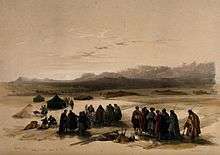Mount Seir
Mount Seir (Hebrew: הַר-שֵׂעִיר; Har Se'ir), today known in Arabic as (Arabic: جبال الشراة; Jibāl ash-Sharāh), is the ancient and biblical name for a mountainous region stretching between the Dead Sea and the Gulf of Aqaba in the northwestern region of Edom and southeast of the Kingdom of Judah. It may also have marked the older historical limit of Ancient Egypt in Canaan.[1] A place called "Seir, in the land of Shasu" (ta-Shasu se`er, t3-sh3sw s`r), thought to be near Petra, Jordan, is listed in the temple of Amenhotep III at Soleb (ca. 1380 BC).

Hebrew Bible

The Hebrew Bible mentions two distinct geographical areas named Seir: a 'land of Seir' and 'Mount Seir' in the South, bordered by the Arabah to the west; and another 'Mount Seir' further north, on the north boundary of Judah, mentioned in Ezekiel ch. 35 and the Book of Joshua (Joshua 15:10).[3]
Southern land of Seir, Mount Seir
Mount Seir was named for Seir the Horite, whose offspring had previously inhabited the area (Genesis 14:6, 36:20). The children of Esau, the Edomites, battled against the Horites and destroyed them (Book of Deuteronomy, Deuteronomy 2:4-5, 12, 22). Mount Seir is specifically noted as the place where Esau made his home (Book of Genesis 32:3; 33:14, 16; 36:8; Joshua 24:4).
In the Book of Numbers, the prophet Balaam, predicting Israelite victories over the Trans-Jordanian nations at the end of their Exodus from Egypt, stated "Edom shall be a possession; Seir also, his enemies, shall be a possession".[4]
Mount Seir is also given as the location where the remnants "of the Amalekites that had escaped" were annihilated by five hundred Simeonites (I Chronicles 4:42-43). In 2 Chronicles 20:22-23, the "inhabitants of Mt. Seir", i.e. the Edomites, came along with the Ammonites and Moabites against Jehoshaphat of Judah, however "the LORD set ambushments" against them,[5] causing their forces to annihilate one another. Mount Seir is also referenced in the prophetic books as a term for Edom, as in Isaiah 21:11 and Ezekiel 25:8 and 35:10.
Northern Mount Seir
There is also another Seir mountain near Hebron which, according to Joshua 15:10, was allotted to the tribe of Judah, near the modern town of Sa'ir in the West Bank of the Palestinian territories.
See also
References
- Steven Grosby (2007). Nationalism and Ethnosymbolism: History, Culture and Ethnicity in the Formation of Nations. Edinburgh University Press. p. 109. ISBN 9780748629350. Retrieved 19 December 2017.
- Encampment in the desert, with Mount Seir in the distance. Coloured lithograph from The Holy Land, Syria, Idumea, Arabia, Egypt, and Nubia by Louis Haghe after David Roberts.
- Sir William Smith (1901). "Seir". Smith's Bible Dictionary. www.biblestudytools.com. Retrieved 19 December 2017.
- Numbers 24:18
- 2 Chronicles 22:22: King James Version